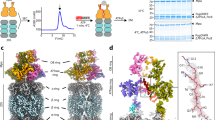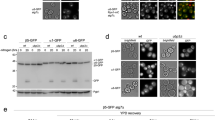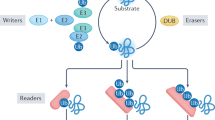Abstract
Proteasomes are ATP-dependent, multisubunit proteases that are found in all eukaryotes and archaea and some bacteria. In eukaryotes, the small protein ubiquitin is covalently attached in a post-translational manner to proteins that are targeted for proteasomal degradation. Despite the presence of proteasomes in many prokaryotes, ubiquitin or other post-translational protein modifiers were presumed to be absent from these organisms. Recently a prokaryotic ubiquitin-like protein, Pup, was found to target proteins for proteolysis by the Mycobacterium tuberculosis proteasome. The discovery of this ubiquitin-like modifier opens up the possibility that other bacteria may also have small post-translational protein tagging systems, with the ability to affect cellular processes.
This is a preview of subscription content, access via your institution
Access options
Subscribe to this journal
Receive 12 print issues and online access
$209.00 per year
only $17.42 per issue
Buy this article
- Purchase on Springer Link
- Instant access to full article PDF
Prices may be subject to local taxes which are calculated during checkout



Similar content being viewed by others
References
Pickart, C. M. & Cohen, R. E. Proteasomes and their kin: proteases in the machine age. Nature Rev. Mol. Cell Biol. 5, 177–187 (2004).
Hershko, A. & Ciechanover, A. The ubiquitin system. Annu. Rev. Biochem. 67, 425–479 (1998).
Ventii, K. H. & Wilkinson, K. D. Protein partners of deubiquitinating enzymes. Biochem. J. 414, 161–175 (2008).
Wilkinson, K. D. Regulation of ubiquitin-dependent processes by deubiquitinating enzymes. FASEB J. 11, 1245–1256 (1997).
Marfany, G. & Denuc, A. To ubiquitinate or to deubiquitinate: it all depends on the partners. Biochem. Soc. Trans. 36, 833–838 (2008).
Kerscher, O., Felberbaum, R. & Hochstrasser, M. Modification of proteins by ubiquitin and ubiquitin-like proteins. Annu. Rev. Cell Dev. Biol. 22, 159–180 (2006).
Johnson, E. S. Protein modification by SUMO. Annu. Rev. Biochem. 73, 355–382 (2004).
Chau, V. et al. A multiubiquitin chain is confined to specific lysine in a targeted short-lived protein. Science 243, 1576–1583 (1989).
Hough, R. & Rechsteiner, M. Ubiquitin–lysozyme conjugates. Purification and susceptibility to proteolysis. J. Biol. Chem. 261, 2391–2399 (1986).
Chen, Z. J. Ubiquitin signalling in the NF-κB pathway. Nature Cell Biol. 7, 758–765 (2005).
Haglund, K. & Dikic, I. Ubiquitylation and cell signaling. EMBO J. 24, 3353–3359 (2005).
De Mot, R., Nagy, I., Walz, J. & Baumeister, W. Proteasomes and other self-compartmentalizing proteases in prokaryotes. Trends Microbiol. 7, 88–92 (1999).
Pearce, M. J., Mintseris, J., Ferreyra, J., Gygi, S. P. & Darwin, K. H. Ubiquitin-like protein involved in the proteasome pathway of Mycobacterium tuberculosis. Science 322, 1104–1107 (2008).
Butler, S. M., Festa, R. F., Pearce, M. J. & Darwin, K. H. Self-compartmentalized bacterial proteases and pathogenesis. Mol. Microbiol. 60, 553–562 (2006).
Zwickl, P., Baumeister, W. & Goldberg, A. L. in Proteasomes: The World of Regulatory Proteolysis (eds Hilt, W. & Wolf, D. H.) 8–18 (Eurekah.com, Georgetown, Texas, 2000).
Lin, G. et al. Mycobacterium tuberculosis prcBA genes encode a gated proteasome. Mol. Microbiol. 59, 1405–1416 (2006).
Hu, G. et al. Structure of the Mycobacterium tuberculosis proteasome and mechanism of inhibition by a peptidyl boronate. Mol. Microbiol. 59, 1417–1428 (2006).
Löwe, J. et al. Crystal structure of the 20S proteasome from the archaeon T. acidophilum at 3.4 Å resolution. Science 268, 533–539 (1995).
Nagy, I., Tamura, T., Vanderleyden, J., Baumeister, W. & De Mot, R. The 20S proteasome of Streptomyces coelicolor. J. Bacteriol. 180, 5448–5453 (1998).
Kwon, Y. D., Nagy, I., Adams, P. D., Baumeister, W. & Jap, B. K. Crystal structures of the Rhodococcus proteasome with and without its pro-peptides: implications for the role of the pro-peptide in proteasome assembly. J. Mol. Biol. 335, 233–245 (2004).
Tamura, T. et al. The first characterization of a eubacterial proteasome: the 20S complex of Rhodococcus. Curr. Biol. 5, 766–774 (1995).
Darwin, K. H., Ehrt, S., Weich, N., Gutierrez-Ramos, J.-C. & Nathan, C. F. The proteasome of Mycobacterium tuberculosis is required for resistance to nitric oxide. Science 302, 1963–1966 (2003).
Pouch, M.-N., Cournoyer, B. & Baumeister, W. Characterization of the 20S proteasome from the actinomycete Frankia. Mol. Microbiol. 35, 368–377 (2000).
Knipfer, N. & Shrader, T. E. Inactivation of the 20S proteasome in Mycobacterium smegmatis. Mol. Microbiol. 25, 375–383 (1997).
Smith, D. M. et al. ATP binding to PAN or the 26S ATPases causes association with the 20S proteasome, gate opening, and translocation of unfolded proteins. Mol. Cell 20, 687–698 (2005).
MacMicking, J. D. et al. Identification of nitric oxide synthase as a protective locus against tuberculosis. Proc. Natl Acad. Sci. USA 94, 5243–5248 (1997).
Shiloh, M. U. & Nathan, C. F. Reactive nitrogen intermediates and the pathogenesis of Salmonella and mycobacteria. Curr. Opin. Microbiol. 3, 35–42 (2000).
Nagy, I., Geert, S., Vanderleyden, J. & De Mot, R. Further sequence analysis of the DNA regions with the Rhodococcus 20S proteasome structural genes reveals extensive homology with Mycobacterium leprae. DNA Seq. 7, 225–228 (1997).
Festa, R. A., Pearce, M. J. & Darwin, K. H. Characterization of the proteasome accessory factor (paf) operon in Mycobacterium tuberculosis. J. Bacteriol. 189, 3044–3050 (2007).
Gandotra, S., Schnappinger, D., Monteleone, M., Hillen, W. & Ehrt, S. In vivo gene silencing identifies the Mycobacterium tuberculosis proteasome as essential for the bacteria to persist in mice. Nature Med. 13, 1515–1520 (2007).
Pearce, M. J. et al. Identification of substrates of the Mycobacterium tuberculosis proteasome. EMBO J. 25, 5423–5432 (2006).
Singh, A., Mai, D., Kumar, A. & Steyn, A. J. Dissecting virulence pathways of Mycobacterium tuberculosis through protein–protein association. Proc. Natl Acad. Sci USA 103, 11346–11351 (2006).
Burns, K. E., Liu, W. T., Boshoff, H. I., Dorrestein, P. C. & Barry, C. E. 3rd. Proteasomal protein degradation in mycobacteria is dependent upon a prokaryotic ubiquitin-like protein. J. Biol. Chem. 284, 3069–3075 (2008).
Soding, J., Biegert, A. & Lupas, A. N. The HHpred interactive server for protein homology detection and structure prediction. Nucleic Acids Res. 33, W244–W248 (2005).
Lehmann, C. et al. YbdK is a carboxylate-amine ligase with a g-glutamyl:cysteine ligase activity: crystal structure and enzymatic assays. Proteins 56, 376–383 (2004).
Iyer, L. M., Burroughs, A. M. & Aravind, L. Unraveling the biochemistry and provenance of pupylation: a prokaryotic analog of ubiquitination. Biol. Direct 3, 45 (2008).
Altschul, S. F. et al. Gapped BLAST and PSI-BLAST: a new generation of protein database search programs. Nucleic Acids Res. 25, 3389–3402 (1997).
Zhang, X. et al. The N-terminal coiled coil of the Rhodococcus erythropolis ARC AAA ATPase is neither necessary for oligomerization nor nucleotide hydrolysis. J. Struct. Biol. 146, 155–165 (2004).
Darwin, K. H., Lin, G., Chen, Z., Li, H. & Nathan, C. Characterization of a Mycobacterium tuberculosis proteasomal ATPase homologue. Mol. Microbiol. 55, 561–571 (2005).
Kessler, D. Enzymatic activation of sulfur for incorporation into biomolecules in prokaryotes. FEMS Microbiol. Rev. 30, 825–840 (2006).
Pedrioli, P. G., Leidel, S. & Hofmann, K. Urm1 at the crossroad of modifications. 'Protein Modifications: Beyond the Usual Suspects' Review Series. EMBO Rep. 9, 1196–1202 (2008).
Leidel, S. et al. Ubiquitin-related modifier Urm1 acts as a sulphur carrier in thiolation of eukaryotic transfer RNA. Nature 458, 228–232 (2009).
Schlieker, C. D., Van der Veen, A. G., Damon, J. R., Spooner, E. & Ploegh, H. L. A functional proteomics approach links the ubiquitin-related modifier Urm1 to a tRNA modification pathway. Proc. Natl Acad. Sci. USA 105, 18255–18260 (2008).
Ikeuchi, Y., Shigi, N., Kato, J., Nishimura, A. & Suzuki, T. Mechanistic insights into sulfur relay by multiple sulfur mediators involved in thiouridine biosynthesis at tRNA wobble positions. Mol. Cell 21, 97–108 (2006).
Numata, T., Ikeuchi, Y., Fukai, S., Suzuki, T. & Nureki, O. Snapshots of tRNA sulphuration via an adenylated intermediate. Nature 442, 419–424 (2006).
Cerdeno-Tarraga, A. M. et al. Extensive DNA inversions in the B. fragilis genome control variable gene expression. Science 307, 1463–1465 (2005).
Giannakis, M., Chen, S. L., Karam, S. M., Engstrand, L. & Gordon, J. I. Helicobacter pylori evolution during progression from chronic atrophic gastritis to gastric cancer and its impact on gastric stem cells. Proc. Natl Acad. Sci. USA 105, 4358–4363 (2008).
Rytkonen, A. & Holden, D. W. Bacterial interference of ubiquitination and deubiquitination. Cell Host Microbe 1, 13–22 (2007).
Ozkaynak, E., Finley, D., Solomon, M. J. & Varshavsky, A. The yeast ubiquitin genes: a family of natural gene fusions. EMBO J. 6, 1429–1439 (1987).
Jin, J., Li, X., Gygi, S. P. & Harper, J. W. Dual E1 activation systems for ubiquitin differentially regulate E2 enzyme charging. Nature 447, 1135–1138 (2007).
Chiu, Y. H., Sun, Q. & Chen, Z. J. E1–L2 activates both ubiquitin and FAT10. Mol. Cell 27, 1014–1023 (2007).
Striebel, F. et al. Bacterial ubiquitin-like modifier Pup is deamidated and conjugated to substrates by distinct but homologous enzymes. Nature Struct. Mol. Biol. 17 May 2009 (doi:10.1038/nsmb.1597).
Acknowledgements
I am grateful to A. Darwin, I. Mohr and H. Ovaa for critical review of this manuscript. I thank the anonymous referees for excellent suggestions and important corrections. I am supported by National Institutes of Health (NIH) grants AI065437 and HL092774 and a Center For AIDS Research Pilot Project grant (NIH S P30 A1027742-17).
Author information
Authors and Affiliations
Related links
Related links
DATABASES
Entrez Genome Project
FURTHER INFORMATION
Rights and permissions
About this article
Cite this article
Darwin, K. Prokaryotic ubiquitin-like protein (Pup), proteasomes and pathogenesis. Nat Rev Microbiol 7, 485–491 (2009). https://doi.org/10.1038/nrmicro2148
Published:
Issue Date:
DOI: https://doi.org/10.1038/nrmicro2148
This article is cited by
-
The pan-genome of the emerging multidrug-resistant pathogen Corynebacterium striatum
Functional & Integrative Genomics (2023)
-
A novel strategy of gene screen based on multi-omics in Streptomyces roseosporus
Applied Microbiology and Biotechnology (2022)
-
Transcriptional analysis of the effect of exogenous decanoic acid stress on Streptomyces roseosporus
Microbial Cell Factories (2013)
-
Enzyme-catalyzed protein crosslinking
Applied Microbiology and Biotechnology (2013)
-
Proteasomes and protein conjugation across domains of life
Nature Reviews Microbiology (2012)



